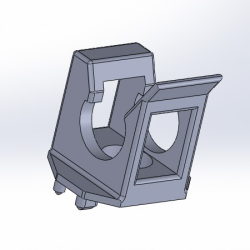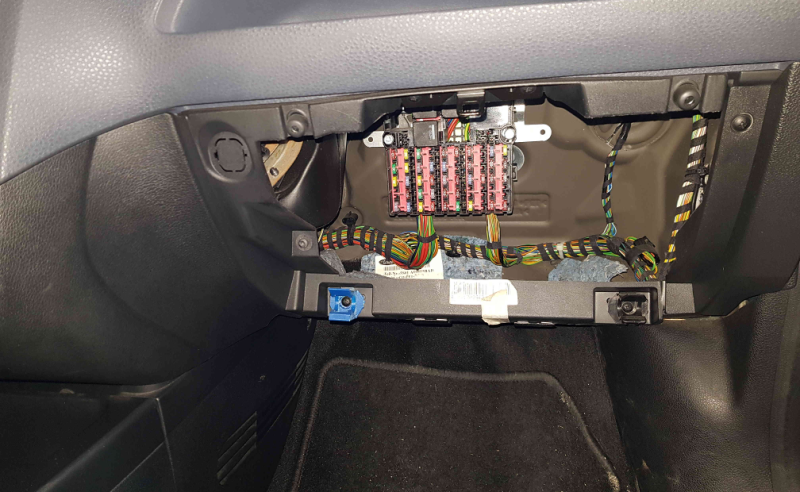A few years ago, [Brieuc]’s car blew a fuse. He went to replace it, which unfortunately means removing the entire glove box. In his haste to get his baby back on the road, he accidentally broke one of the clips that holds the glove box on the dashboard.
 [Brieuc] tried to just glue the thing back together, but it didn’t hold because the part has to flex a little bit for people who need to get into the fuse box. No one seems to offer a replacement for this small but vital hunk of plastic, though he did find someone offering total glove box replacements at highway robbery prices. Since there was still one good clip, he used it to design and print a strong ABS replacement.
[Brieuc] tried to just glue the thing back together, but it didn’t hold because the part has to flex a little bit for people who need to get into the fuse box. No one seems to offer a replacement for this small but vital hunk of plastic, though he did find someone offering total glove box replacements at highway robbery prices. Since there was still one good clip, he used it to design and print a strong ABS replacement.
This is a great example of the one-off utility of 3D printers. [Brieuc] didn’t need an exact copy, and since he was replacing an injection-molded part with additive manufacturing, he had the freedom to start with a bare-bones design, make adjustments as needed, and iterate until he got it right. It didn’t take long. The layer orientation of the first print made the legs too weak, but that’s a simple fix. The second version has lasted for three years and counting.
We get it. You don’t have the same car as [Brieuc], so this particular fix doesn’t sway you. But someday in the future when your zipper breaks or your dishwasher detergent cup won’t latch, 3D printing will be there to help.















That’s good he went for ABS. I printed up some sun visor clips for my daughters VW beetle a couple of years ago in PLA. They worked great till summer came around and they melted :o
Drill press, file and it’d be done in 30 mins.
The $800 I paid for my AirWolf3D back around 2011 has easily been paid off just by printing personal replacement parts. But to grab that value requires some basic authoring skills, I use OpenSCAD because it is easier for me to hack code than boot a virtualbox of win7 and then slog through making parts with SolidWorks. Solidworks it great for assemblies but OpenSCAD is parametric and written code based, with practice pretty fast for designing one small part and faster to edit if the fit is a little off.
It is possible to find many replacement parts on thingiverse.com, but especially if you have the broken part it seems a shot in the dark printing someone else’s no-code .STL vs measuring, coding, slicing, and printing.
I highly recommend publishing any working parts, thingiverse has issues but inertia for me, but publish for those who dont know how, and publish with a libre release license your source code so they can learn and save time by just modifying your code.
1++
error: lvalue required as increment operand
One++
The newer FreeCAD supports OpenSCAD inside as a plug-in…
And it does IGES just fine…
I really think these folks do not get enough free beers from the community.
Maybe send a feature request for direct g-code export from OpenSCAD, and thus eliminate most CAD format issues ;-)
Perhaps you should break stuff less? I can’t believe I’ve spent anywhere near $800 buying replacement items in the last 7 years.
Or do you have unusual requirements?
I take good stuff that is broken and make it my own for free or cheap, printing parts means I save big money on appliances.
Not everybody needs virtualbox for Win7. I just have to get my computer out of standby/powersave mode and there is Win 7. Fortunately I could avoid Win 10 up to now.
Another thing to remember is you are not required to copy a lost/broken part 1:1, just it’s function and fit. 3D printing is weaker than injection molding, design your replacement to be easy to code, easy to print, and strong enough to last. Also remember that you can plastic+acetone=goop glue together an assembly if you need a stronger part across the grain or one that can’t be printed strong whole because of overhang support requirements.
Another good point… beef it up in any possible dimension.
I predict the 3D printing machines at Walgreens in near future. You order to print your part online from a catalog and get it at nearest Walgreens.
It seems probable, but customers would not accept screwed up prints (as with printed photographs) and Walgreens (or whoever) would have to eat the cost, even if it was entirely the customer’s fault.
And I feel that an average Walgreen customer would have no clue about how to design a print.
Even if they were to pull one off of thingiverse, there would be a large probability they chose the wrong file,
(“Why won’t the glove compartment hinge of a 1985 Chevy Cavalier work on my 2011 Toyota Highlander?”
Probably the will make TOS (have too), that they will not eat the cost, if the customer chose the wrong part. Of course if their printer malfunctions, it’s another thing.
UPS has 3d printing services in a bunch of their stores now, not sure how it works as far as pricing and avalible materials but the services are indeed starting to show up.
I feel (as a non-3D printererer) that this contest is giving me more “reason” to get started in 3D printing.
And if others feel the same way, (Hey, this is more useful than I thought!). It will give a boost to the craft as more people, ideas, skillsets, files (as on thingiverse) come into play.
I noticed the same, it makes me want to start 3D printing really bad, although I have other ways to fix broken things (it’s surprising how well zipties and duct-tape can hold in an engine bay).
But I don’t think 3D printing can fix everything, I fixed my bike’s rusted mudguard with some steel band, beefy screws and anti-rust paint, it seems much more “Skookum” than 3D printed stuff).
@Ren: Come to the dark side!
Seriously, 3D printing solves many problems, but it also “creates” problems that you didn’t know you had that needed solving. Problems that you could “more elegantly” solve with a fun design session and a print.
Re: zip ties, for instance. I see soooooo many different designs for belt tensioner apparati for 3D printers, but the best one I’ve ever used has been a zip tie. Because you only ever need to tighten, and if you overtighten, it’s only cost you $0.005 to snip it off and do over. (Money where my mouth is.)
But if you use the zip-tie solution, you don’t learn anything about designing parts for yourself either. And building a tensioner is a great first step into mechanical design. It’s not like people _need_ blinking LEDs either. It’s the journey, not the destination.
This is very cool, 3 d printer!
How many times can you change this fuse. One, two, three …. or this attachment will break in a week. These are different plastics, think man!
PS I am Russian!You will understand!
So print a spare. Or selectively strengthen sections with epoxy. Or cast a replacement. He already said a replacement part was unavailable/prohibitively expensive. What’s your solution?
Use 3D printer to print either a master or directly print the mold (either of which you should fine-finish with hand tools), then cast with epoxy resin (or injection mold if you have the press)…unless you fuck up the casting, you’ll have a part that is stronger then the 3D printed one and it should not exhibit any anisotropy, for which 3D parts are famous for.
I would try to selectively strengthen it by making it thicker were possible. Adding a dissimilar material with different mechanical/thermal properties is probably not working very good.
This is a cool fix, but… Why not just go to a wrecking yard and get one? I broke a storage compartment clip doing something very similar on my 20-year-old Jeep; a 30 minute drive and $2 ($1 to come in, $1 for the part) netted me an OEM part.
It’s the perfect time to get some answers concerning the auto and what our auto needs from us and honest to goodness mind should be given right now as to shield from the critical disaster and constantly take the help from the masters.